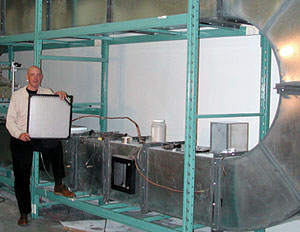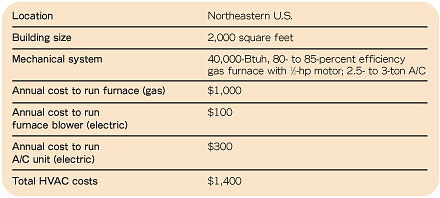
Cimatec's products are 1- and 2-inch electronic air cleaners that fit into standard filter racks found on most residential-type air-handling systems. The filters' size and easy installation make them ideal for portable classrooms, Roblin said. These structures have be-come notorious for their poor IAQ, but they are necessary for school districts strapped for cash and classroom space.
The filters use Electronic Bipolarization Technology (EBT), Roblin explained, which allows them to trap submicron-size particles with minimal pressure drop.
"We have an ongoing commitment to EBT at our R&D facility that includes a rather unique, ASHRAE-compliant, 72- by 12-foot closed-loop wind tunnel, clean room, and acoustics chamber," he said.
"The results of our ‘new' technology" - developed within the last 15 years, a relatively short time in the HVAC realm - "is beginning to have an impact in the submicron filtration marketplace both for our efficiency and at a very low price point in comparison to many of the traditional electronic solutions which are expensive to buy and install," Roblin said. "Ours simply fit into the existing 1- and 2-inch tracks standard on most systems."
Schoolroom Applications
The company's 1-inch Aircleen 1500 Model can be installed in a standard 1-inch track on most heating and air conditioning units attached to portable schoolroom buildings, Roblin said. He noted that these have become very popular in the last 10 years."Now that IAQ is becoming more of an issue, and many school districts are beginning to understand the financial implications, as well as the impact on the health of students and teachers, they will be-gin to find the money to help fix the problem," he said. "There is no shortage of expensive solutions."
He noted that "while many electronic solutions are out there - certainly on the residential side - the equipment can be a lot bigger."
In such cases, retrofitting needs to be done by the contractor. This adds to the cost of the installation due to materials as well as labor. "Our technology is like a typical throwaway filter," Roblin said. "It slides into the 1-inch slot."
At the same time, the product's use of EBT takes its ability to filter particles down to the submicron level. In other words, it filters air for the protection of people, not just the equipment.
"Our filter is easily installed, easy and inexpensive to maintain," Roblin said. "Our performance, especially in a recirculation environment [typical of portable classrooms], is exceptional."
He said the company has confirmed its products' performance down to the 0.009-micron level. This, he said, "confirms performance superior to a passive filtration system like a HEPA filter."
Roblin continued, "You get very, very high-end filtration, submicron filtration, without the expense of retrofitting. For schools, it's an acceptable IAQ solution," particularly for portable classrooms.
"Schools, unfortunately, are not aware of our technology. Perhaps for budgetary reasons, they only use the throwaway filters that do not filter below 1 micron. What a use of money!"
Using The Product
The filter is inserted into the same 1-inch filter slot found in most residential heating-cooling forced-air systems, Roblin explained. It plugs into a 24-V power source. No retrofitting is required. When it's time to maintain the unit, "You pull the filter media out of the unit about four times a year, on the seasons. If the environment is dirtier, you may need to do it more often," but four times a year is a good place to start.The filter frame "pops open like a sandwich," Roblin said. "You take the dirty pieces of media, throw them in the garbage, and pop a new one back in. It takes maybe a minute, maybe two. There is no washing, no scrubbing. In many ways it's like a vacuum cleaner bag. You take out the old one, slide in a new one, and off you go."
Airflow and pressure drop can be a concern for some higher efficiency filters, which tend to load up quicker because of their tight media patterns. "We have an exceptionally low pressure drop," Roblin said. "It's half the pressure drop of many leading passive filters.
"For a typical, old-fashioned pleated filter, let's think baseball: Think about the pitcher on the mound, throwing the baseball to the catcher." If the baseball is a particulate, "The catcher has to use his mitt to stop it," Roblin explained. "The tighter the weave, the smaller the particulate and the less air can get through."
With the company's EBT utilization, "Think of our filter as a giant electronic magnet," he said. "It grabs the particulate out of the air with a much looser weave. Air flows through very easily and nicely. Best of both worlds."

Operational Costs
Airflow can have a big impact on a customer's costs, Roblin pointed out. For example, the company's Model 1500 has a pressure drop rating that is about half that of a leading pleated throwaway filter, he said. "That means the air flows through the Cimatec filter more easily while providing exceptional air quality."He said research shows that with the product's low pressure drop, total heating, air conditioning, and electrical costs can be reduced by up to 15 percent compared to a standard throwaway filter.
"We only use 2 watts of power," Roblin said. "The annual cost to operate it is about $2.50. A typical, traditional electronic air filter can cost about $100 a year to operate. They use 110 voltage. Ours is highly effective on the grid."
Roblin cited the figures in Table 1 for a breakdown of approximate operating costs for a typical home in a moderate environment. Results could be similar or better for a portable classroom.
"Some of us remember when the first cell phones came out," he said. "They were big and bulky and hard to move around. Now they fit in the palm of your hand. We're the modern electronic air filter," he said. "We're Mighty Mouse."
Publication date: 11/08/2004

Report Abusive Comment